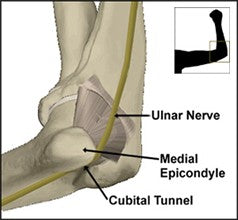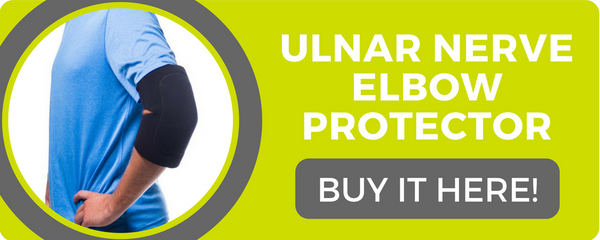Ulnar Nerve Pain in Elbow or Wrist

The ulnar nerve is one of the three main nerves of the arm, and it is also one of the most commonly compressed nerves. This compression can occur in a variety of places, affecting where and how the ulnar pain manifests and what ulnar nerve compression treatment is used.
The ulnar nerve extends from the neck all the way through the arm and forearm to the tips of the little and ring fingers. As it transverses the body, it runs through a series of tunnels and bone structures where it can be compressed, irritated or entrapped. For instance, it can be trapped beneath the collarbone, behind the elbow, exiting the spinal cord causing ulnar nerve neck pain, or at the wrist. Some women with large breasts may even suffer ulnar nerve shoulder pain due to the pressure a bra strap can impose on the ulnar nerve.
This nerve is responsible for sensory innervations of the palm side of the fifth finger and the adjacent half of the fourth finger as well as both the front and back of the fingertips. The ulnar nerve also controls the majority of the little muscles in the hands that are crucial for fine finger movement in addition to some of the larger muscles in the forearm that are instrumental in strengthening one’s grip.
What is Ulnar Nerve Elbow Pain?
The most common source of pain in ulnar nerve compression is at the elbow; indeed, this injury is the second most common entrapment disorder after carpal tunnel syndrome. The ulnar nerve is often compressed on its path through the cubital tunnel at the outer part of the elbow—thus, it is also called cubital tunnel syndrome. Here, it passes through a very narrow space with little protective covering.

Think about the last time you hit your “funny bone.” What actually caused the odd sensation of elbow pain—ulnar nerve compression. This gives you an idea of the symptoms and causes of this condition.
But ulnar nerve pain symptoms from compression are not limited to ulnar nerve pain in elbow. Besides an aching pain at the inner part of the elbow, one might also experience a pins-and-needles type of ulnar nerve hand pain and numbness in the fourth and fifth fingers as well as at the back of the hand. This, in turn, can compromise the hand’s fine motor abilities and weaken one’s grip.
Typically, cubital tunnel syndrome symptoms flare up in the middle of the night or early in the morning. But if ulnar nerve injury treatment is not pursued, the discomfort and debilitating side effects could become chronic and result in muscle atrophy or development of finger deformity known as the “Ulnar Claw" or "Spinter's Claw"
Ulnar Nerve Treatment for the Elbow
Many ulnar nerve pain treatment options involve addressing the cause and thankfully, most cases are relatively mild. The ulnar nerve can become compressed at the elbow by repeated or extended periods when one has the arms sharply bent. One common cause, for instance, is sleeping with the arms folded and elbows bent sharply. An elbow brace that compresses the ulnar nerve can be helpful for preventing one from bending his or her arms at night.
Leaning on one’s elbows, especially against a hard surface can also be problematic. This might occur when one leans on a counter or table, or it might occur when resting the elbow on an armrest. One should take care to avoid this type of pressure as much as possible. Again, wearing an ulnar nerve elbow brace may provide some protective cushion and/or a reminder to exercise better posture. Anti-inflammatory medications can also be helpful.
Injury to the elbow region or cubital tunnel or conditions that cause inflammation of the joints, such as rheumatism, infection, alcoholism, diabetes, hypothyroidism or tumors, can also cause ulnar wrist, elbow or hand pain. In such cases, addressing the underlying issue will likely be needed for achieving ulnar nerve pain relief. In the meantime, an elbow brace ulnar nerve support might be helpful for minimizing the discomfort.
What is Ulnar Wrist Pain and what Causes it?
Another location that is often the site of ulnar nerve compression is the wrist. Here, the ulnar nerve can be pressured as it passes through what is known as Guyon’s Canal. Therefore, this type of pain in the ulnar side of the wrist is known as Guyon’s Canal Syndrome or Guyon’s tunnel syndrome.
It is quite similar to carpal tunnel in terms of causes and symptoms; it just involves a different nerve. Thus, these two conditions may occur together.
This ulnar wrist injury can stem from a number of causes that put either acute or repetitive force on the wrists. Pain on ulnar side of the wrist is common among cyclists, for instance, as some bikers spend long periods with the palm/wrist area is pressed against the handlebars of their bike. Thus, this condition is also sometimes referred to as handlebar palsy or bicycler’s neuropathy.
Other sports where this injury is common are golf, tennis, and baseball. In these sports, gripping the golf club, tennis racket or baseball bat causes repetitive stress on the ulnar nerve. And a player’s swinging action can fracture the hamate bone, which can cause ulnar nerve wrist pain as it can hinder the nerve’s passage through the Guyon canal.
Weightlifting can also compromise the Guyon canal and cause wrist ulnar pain. Or one might compress the ulnar nerve simply by pressing the wrist against a hard surface as one clicks a mouse, for instance.
The use of vibrating hand tools is also thought to be a causal factor for wrist pain, ulnar side. Likewise, those who race motorcycles or cars frequently, thereby pairing vibration and pressure on the wrist, often suffer from ulnar-side wrist pain.
Ulnar nerve compression in the wrist can also stem from internal causes like cysts, arthritis, deformities or injuries to the wrist area.
Ulnar-Sided Wrist Pain Symptoms and Guyon’s Canal
The symptoms of Guyon’s canal syndrome are largely the same as that of cubital tunnel syndrome with a few exceptions. Like compression to the ulnar nerve at the elbow, this ulnar nerve wrist injury causes a pins and needle or tingling sensation in the pinky and ring finger and/or the palm, a burning sensation in the wrist and/or numbness and clumsiness.
But unlike cubital tunnel syndrome, his type of ulnar nerve compression does not affect the back of the hand. Also, the development of the ulnar claw hand is typically more pronounced with this injury type.
How Do I Treat Ulnar Wrist Pain?
The first step for pinched ulnar nerve treatment is to stop or avoid tasks that irritate the wrist as much as possible. When that is not an option, make sure to take frequent breaks from the activity and restrict the amount of time one spends doing it. Taking anti-inflammatory medications can help with the resulting inflammation and the ulnar-side wrist pain.
An ulnar nerve brace can help by reducing pressure on the wrist and stimulating blood flow to reduce inflammation and promote healing. An ulnar brace can also provide some protective padding for the wrist, which is helpful for ulnar-sided wrist pain treatment and prevention. There are also ulnar nerve supports to prevent strain on the wrist at night.
There are also a number of ergonomic aids that reduce problematic strain on the wrists, such as wrist braces, special computer mouses, wrist rests for keyboards or jar openers.
Unfortunately, conservative modes of treatment are not always successful in treating ulnar nerve pain. In such cases, surgery to transpose or decompress the nerve (or some combination of the two) may be necessary.
The primary risks of ulnar neuropathy surgery are an infection or bleeding, though there is a chance for the persistence of numbness or pain after ulnar nerve surgery if the procedure is ineffective. At BraceAbility, you can also find wrist and elbow braces for supporting these areas after surgery or following the removal of a cast.











